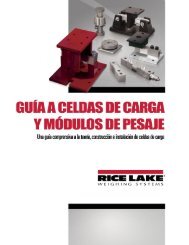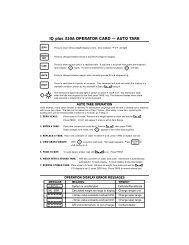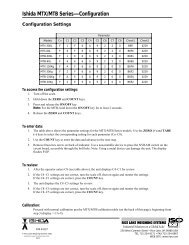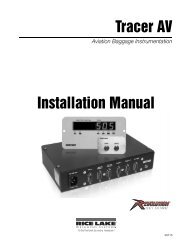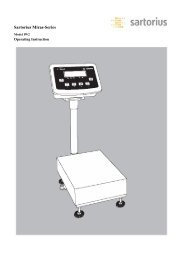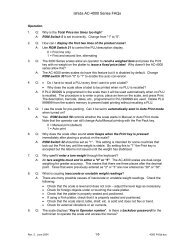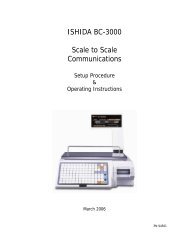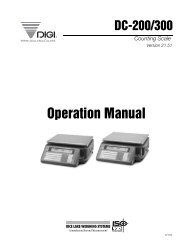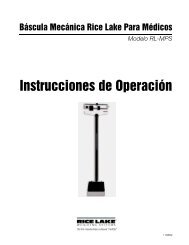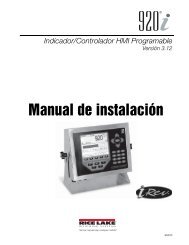IQ plus® 800/810 - Rice Lake Weighing Systems
IQ plus® 800/810 - Rice Lake Weighing Systems
IQ plus® 800/810 - Rice Lake Weighing Systems
Create successful ePaper yourself
Turn your PDF publications into a flip-book with our unique Google optimized e-Paper software.
6.0 EDP CommandsThe <strong>IQ</strong> plus <strong>800</strong>/<strong>810</strong> indicators can be controlled by apersonal computer or remote keyboard connected tothe indicator EDP port. Control is provided by a set ofEDP commands that can simulate front panel keypress functions, display and change setup parameters,and perform reporting functions. The EDP portprovides the capability to print setpoint andconfiguration data, to save that data to an attachedpersonal computer, or to transfer configuration datafrom one indicator to another. This section describesthe EDP command set and procedures for printing,saving, and transferring data using the EDP port.6.1 The EDP Command SetThe EDP command set can be divided into fivegroups: key press commands, reporting commands,special function commands, parameter settingcommands, and transmit weight data commands. Thefollowing sections list the commands and commandsyntax used for each of these groups.6.1.1 Key Press CommandsKey press EDP commands (see Table 6-1) simulatepressing the keys on the front panel of the indicator.They can be used in both setup and operating mode.Several of the commands serve as “pseudo” keys,providing functions that are not represented by a keyon the front panel.After the indicator receives a key press command, itresponds with the message OK. The OK responseverifies that the command was received. Note that thisresponse does not confirm that a requested action wascompleted. For example, the indicator will respondwith OK even after it disallows a ZERO function.An example of using the EDP commands is asfollows: To enter a 15-pound tare weight using EDPcommands:1. Type K1 and press ENTER (or RETURN).2. Type K5 and press ENTER.3. Type KTARE and press ENTER.4. The indicator shows the pT (keyboard tare)symbol and switches to net mode.CommandFunctionKZEROPress the ZERO keyKGROSSNET Press the G/N keyKGROSSGo to Gross mode (pseudo key)KNETGo to Net mode (pseudo key)Table 6-1. EDP Key Press CommandsCommandFunctionKTAREPress the TARE keyKUNITSPress the UNITS keyKPRIMGo to primary units (pseudo key)KSECGo to secondary units (pseudo key)KPRINTPress the PRINT keyKCLRPress the CLEAR keyKNEWIDPress the NEWID keyKSETPOINT Press the SETPOINT keyKBASEPress the SCALE# keyKTOTALDisplay the TOTAL channel (pseudokey)KDISPTARE Press the DISP TARE keyKDISPACCUM Press the DSIP ACCUM keyKDISPROC Press the DISP ROC keyKTIMEDATE Press the TIME/DATE keyKDATEDisplay the date (pseudo key)KTIMEDisplay the time (pseudo key)KLEFTARROW In setup mode, move right in themenu; in weighing mode, press theSETPOINT keyKRIGHTARROW In setup mode, move left in the menu;in weighing mode, press the CLEARkeyKUPARROW In setup mode, move up in the menu;in weighing mode, press the DISPTARE keyKDOWNARROW In setup mode, move down in themenu; in weighing mode, press theTIME/DATE keyK0Press number 0 (zero)K1 Press number 1K2 Press number 2K3 Press number 3K4 Press number 4K5 Press number 5K6 Press number 6K7 Press number 7K8 Press number 8K9 Press number 9KDOT Press the decimal point (.)KENTERPress the ENTER keyTable 6-1. EDP Key Press Commands (Continued)EDP Commands 45



